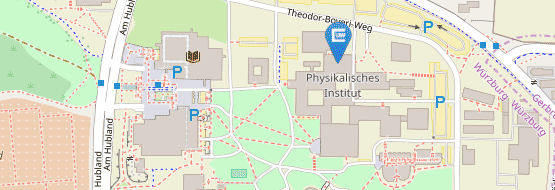Berengar Leikert (PhD thesis): Spectroscopic and transport investigation of the electronic phase diagram of the Mott material LaTiO3
Transition metal oxides harbor a plethora of emergent electronic phases unaccounted for in conventional band theory. The reason hereto is the strong localization of electrons in the conduction bands with d-orbital character, inducing electron-electron interactions. One of these emergent phenomena is so called Mott-insulating behavior where materials with half band filling, metals according to band theory, show insulating behavior. In this case, the onsite Coulomb repulsion is strong enough to impede electron hopping and thus the creation of doubly occupied sites. If the band filling of such materials is then changed sufficiently from integer band filling, the band filling induced Mott transition (MMIT) from the Mott insulating to the correlated metal regime can be triggered, where all previously localized delectrons then contribute to electronic transport. A prototypical material and in the focus of this thesis, is the perovskite Mott insulator LaTiO3 (LTO) with a Ti 3d1 configuration. In recent years, oxygen excess doping was discovered as means to tune LaTiO3 thin films close to and across the band filling induced MMIT [1]. This opens the path to using LTO in a Mott transistor, as the band filling can also be changed by an external electric field applied by a gate electrode. The merit of such a Mott transistor would be the extremely high carrier concentration compared to conventional transistors. In this thesis, first steps towards an implementation of LTO into a Mott transistor are taken. The low Thomas-Fermi screening length of 1-2 unit cells, caused by said high carrier concentration, poses the most significant hurdle to using LTO as channel material in a Mott transistor. Therefore ultrathin LTO films approaching the 2D limit are prepared and analyzed by photoemission spectroscopy and complementary electronic transport measurements. It is found that upon reduction of the film thickness, the LTO films become stronger Mott insulating, shifting the MMIT to higher doping concentrations away from integer band filling. The most likely explanation is found to be reduced hopping in one dimension effectively reducing the bandwidth. The shift of the MMIT is so large in two unit cells thick LTO films, that it becomes inaccessible by oxygen excess doping. Thus, compressive epitaxial strain is employed to effectively increase the LTO bandwidth and reaccess the band filling induced MMIT. For that, thin epitaxial LTO films were grown on the substrate materials GdScO3, DyScO3, NdGaO3 and LaAlO3, each exerting more compressive strain in this order. NdGaO3 was found to be incompatible to LTO due to the high ion interdiffusion. For the other materials, an effect of compressive epitaxial strain was found, represented by a smaller energy gap. But even for ultrathin LTO films on LaAlO3, exerting −4.2% compressive strain, the band filling induced MMIT stayed inaccessible. This indicates that the effect of dimensionality eclipses that of compressive strain. Another focus of this thesis is to investigate the band filling induced MMIT of LTO thin films directly with angle-resolved photoemission spectroscopy (ARPES). It is found that the quasiparticle effective mass increases when approaching the band filling induced MMIT from the metallic side, as predicted by Brinkman and Rice and more sophisticated dynamical mean field theory [2, 3]. Furthermore, a phase separation between band insulating d0 and dδ domains is found at low band fillings. Lastly, the interface between LTO and the band insulator SrTiO3 is investigated. Multiple different effects lead to a conducting interface between these materials where interesting transport properties were detected. Most prominent among them is a colossal linear magnetoresistance of up to 6500%, that is traced back by Lorentz transmission electron microscopy to magnetic spiral states evolving upon applied magnetic field. Using photoemission spectroscopy it is determined which layers participate to the electronic transport. But the absolute thickness of the conducting layer(s) remains an open question.
[1] P. Scheiderer, M. Schmitt, J. Gabel, M. Zapf, M. St¨ubinger, P. Schütz, L. Dudy, C. Schlueter, T.-L. Lee, M. Sing and R. Claessen, Advanced Materials 30, 1706708 (2018).
[2] W. F. Brinkman and T. M. Rice, Physical Review B 2, 4302 (1970).
[3] A. Georges, G. Kotliar, W. Krauth and M. J. Rozenberg, Reviews of Modern Physics 68, 13 (1996).

